Morpho-molecular characterisation of Arecophila, with A.australis and A.clypeata sp. nov. and A.miscanthi comb. nov
- PMID: 35585934
- PMCID: PMC9021158
- DOI: 10.3897/mycokeys.88.79475
Morpho-molecular characterisation of Arecophila, with A.australis and A.clypeata sp. nov. and A.miscanthi comb. nov
Abstract
Three arecophila-like fungal samples were collected on dead culms of gramineous plants in China. Morphological studies of our new collections and the herbarium specimen of Arecophilagulubiicola (generic type) were conducted and the morphological affinity of our new collections with Arecophila was confirmed. Maximum likelihood and Bayesian analyses using combined ITS, LSU, rpb2 and β-tubulin data from our collections revealed the phylogeny of Cainiaceae. The monospecific genus Alishanica (type species Al.miscanthi), which had been accepted in Cainiaceae, is revisited and synonymised under Arecophila. Based on morphology and phylogeny, Arecophilaaustralis sp. nov. and A.clypeata sp. nov. are introduced as new species, while A.miscanthi is a new record for China. All the new collections are illustrated and described.
Keywords: Cainiaceae; gramineous plants; phylogeny; taxonomy.
Qi Rui Li, Xu Zhang, Yan Lin, Milan C. Samarakoon, Kevin David Hyde, Xiang Chun Shen, Wan Qing Liao, Anuruddha Karunarathna, Si Han Long, Ying Qian Kang, Ji Chuan Kang.
Figures
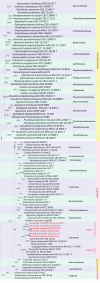
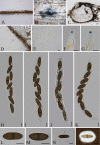
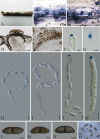
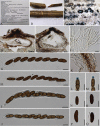
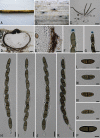
Similar articles
-
Paramphibambusabambusicola gen. et. sp. nov., Arecophilaxishuangbannaensis and A.zhaotongensis spp. nov. in Cainiaceae from Yunnan, China.MycoKeys. 2024 Apr 16;104:113-132. doi: 10.3897/mycokeys.104.117872. eCollection 2024. MycoKeys. 2024. PMID: 38665974 Free PMC article.
-
Addition of three new species of Xylariomycetidae fungi on bamboo from Southern China.MycoKeys. 2024 Oct 2;109:109-129. doi: 10.3897/mycokeys.109.128020. eCollection 2024. MycoKeys. 2024. PMID: 39391866 Free PMC article.
-
The Luciolinae of S. E. Asia and the Australopacific region: a revisionary checklist (Coleoptera: Lampyridae) including description of three new genera and 13 new species.Zootaxa. 2019 Oct 18;4687(1):zootaxa.4687.1.1. doi: 10.11646/zootaxa.4687.1.1. Zootaxa. 2019. PMID: 31719466
-
Stick insects of Sulawesi, Peleng and the Sula Islands, Indonesiaa review including checklists of species and descriptions of new taxa(Insecta: Phasmatodea).Zootaxa. 2021 Dec 6;5073(1):1-189. doi: 10.11646/zootaxa.5073.1.1. Zootaxa. 2021. PMID: 35390842 Review.
-
Review of Madagascaran Agalliini (Hemiptera: Cicadellidae: Megophthalminae) with descriptions of a new genus and six new species.Zootaxa. 2013 Feb 18;3616:1-21. doi: 10.11646/zootaxa.3616.1.1. Zootaxa. 2013. PMID: 24758788 Review.
Cited by
-
Palm Fungi and Their Key Role in Biodiversity Surveys: A Review.J Fungi (Basel). 2023 Nov 19;9(11):1121. doi: 10.3390/jof9111121. J Fungi (Basel). 2023. PMID: 37998926 Free PMC article. Review.
-
Requienella populi sp. nov. (Requienellaceae, Xylariales) from the bark of living aspen trees in Western Norway.Fungal Syst Evol. 2025 Jun;15:225-234. doi: 10.3114/fuse.2025.15.10. Epub 2025 Feb 28. Fungal Syst Evol. 2025. PMID: 40161324 Free PMC article.
-
Spirodecosporaceae fam. nov. (Xylariales, Sordariomycetes) and two new species of Spirodecospora.Fungal Syst Evol. 2022 Dec;10:217-229. doi: 10.3114/fuse.2022.10.09. Epub 2022 Dec 7. Fungal Syst Evol. 2022. PMID: 36741553 Free PMC article.
-
Paramphibambusabambusicola gen. et. sp. nov., Arecophilaxishuangbannaensis and A.zhaotongensis spp. nov. in Cainiaceae from Yunnan, China.MycoKeys. 2024 Apr 16;104:113-132. doi: 10.3897/mycokeys.104.117872. eCollection 2024. MycoKeys. 2024. PMID: 38665974 Free PMC article.
-
Addition of three new species of Xylariomycetidae fungi on bamboo from Southern China.MycoKeys. 2024 Oct 2;109:109-129. doi: 10.3897/mycokeys.109.128020. eCollection 2024. MycoKeys. 2024. PMID: 39391866 Free PMC article.
References
-
- Chomnunti P, Hongsanan S, Aguirre-Hudson B, Tian Q, Peršoh D, Dhami MK, Alisa AS, Xu JC, Liu XZ, Stadler M, Hyde KD. (2014) The sooty moulds. Fungal Diversity 66(1): 1–36. 10.1007/s13225-014-0278-5 - DOI
-
- Crous PW, Wingfield MJ, Guarro J, Cheewangkoon R, van der Bank M, Swart WJ, Stchigel AM, Cano-Lira JF, Roux J, Madrid H, Damm U, Wood AR, Shuttleworth LA, Hodges CS, Munster M, de Jesús Yáñez-Morales M, Zúñiga-Estrada L, Cruywagen EM, De Hoog GS, Silvera C, Najafzadeh J, Davison EM, Davison PJN, Barrett MD, Barrett RL, Manamgoda DS, Minnis AM, Kleczewski NM, Flory SL, Castlebury LA, Clay K, Hyde KD, Maússe-Sitoe SND, Chen S, Lechat C, Hairaud M, Lesage-Meessen L, Pawłowska J, Wilk M, Śliwińska-Wyrzychowska A, Mętrak M, Wrzosek M, Pavlic-Zupanc D, Maleme HM, Slippers B, Mac Cormack WP, Archuby DI, Grünwald NJ, Tellería MT, Dueñas M, Martín MP, Marincowitz S, de Beer ZW, Perez CA, Gené J, Marin-Felix Y, Groenewald JZ. (2013) Fungal Planet description sheets: 154–213. Persoonia 31(4): 188–296. 10.3767/003158513X675925 - DOI - PMC - PubMed
LinkOut - more resources
Full Text Sources
